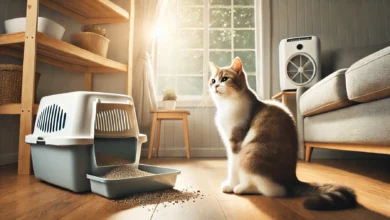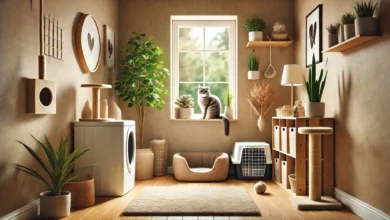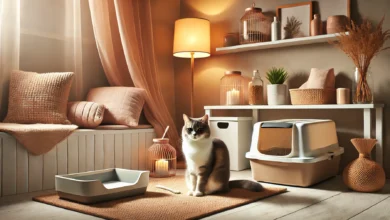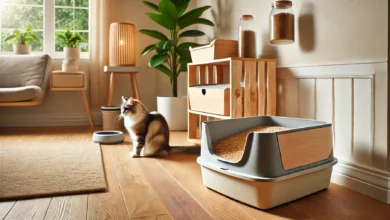How to Clean a Cat Litter Box Properly and Safely
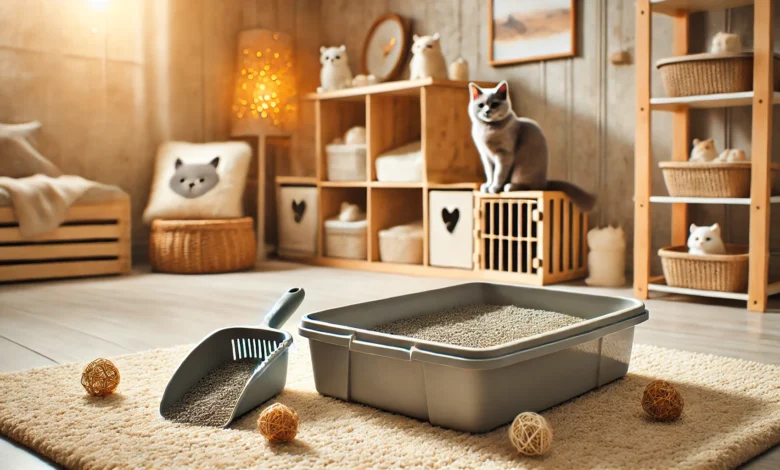
Cleaning your cat’s litter box is important for both their comfort and overall health and hygiene.
Cats are clean animals by nature, and a dirty litter box could give them stress they do not need, which can result in unwanted behavioral changes such as undesirable elimination.
Besides just keeping your house fresh and free from odors, having a clean and safe litter box is crucial to avoid infections and health-related issues that can arise from unsanitary conditions.
If you are wondering how to clean a cat litter box properly and safely, you are in the right place.
We will guide you through each step so you and your feline companion can enjoy happiness and health.
Table of Contents
Choosing the Right Litter Box for Your Cat
The first step in keeping your cat’s litter box clean and hygienic is to make sure you have the right one.
There are so many options available that it’s easy to get confused.
However, by understanding your cat’s preferences and needs, you will be able to pick the right litter box with more confidence.
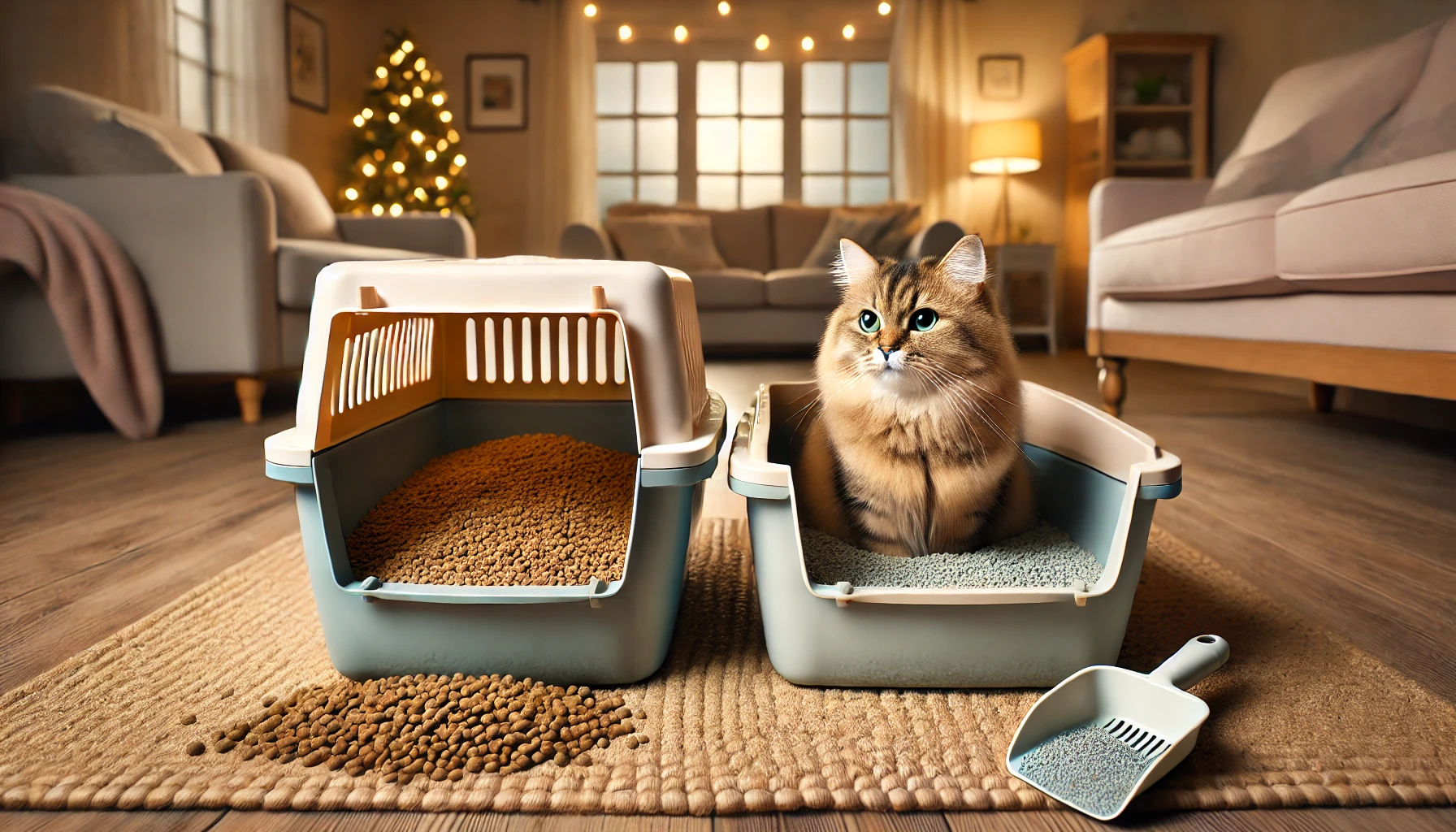
Types of Litter Boxes: Open vs. Covered
There are two basic types of litter boxes: open and covered.
As the name suggests, an open litter box is open on all sides and allows your cat to see in every direction while using it.
This type of box is perfect for cats that prefer easy access, and for owners who want to check the condition of the litter box at any moment.
However, open litter boxes might not be the best option if you want to contain odor or if your cat prefers more privacy.
On the other hand, covered litter boxes offer more seclusion for your cat and help reduce odors.
Some cats like the enclosed space, while others may feel confined or uneasy using them.
When choosing a covered litter box, ensure it is large enough for your cat to turn around comfortably, and that the entrance is easily accessible.
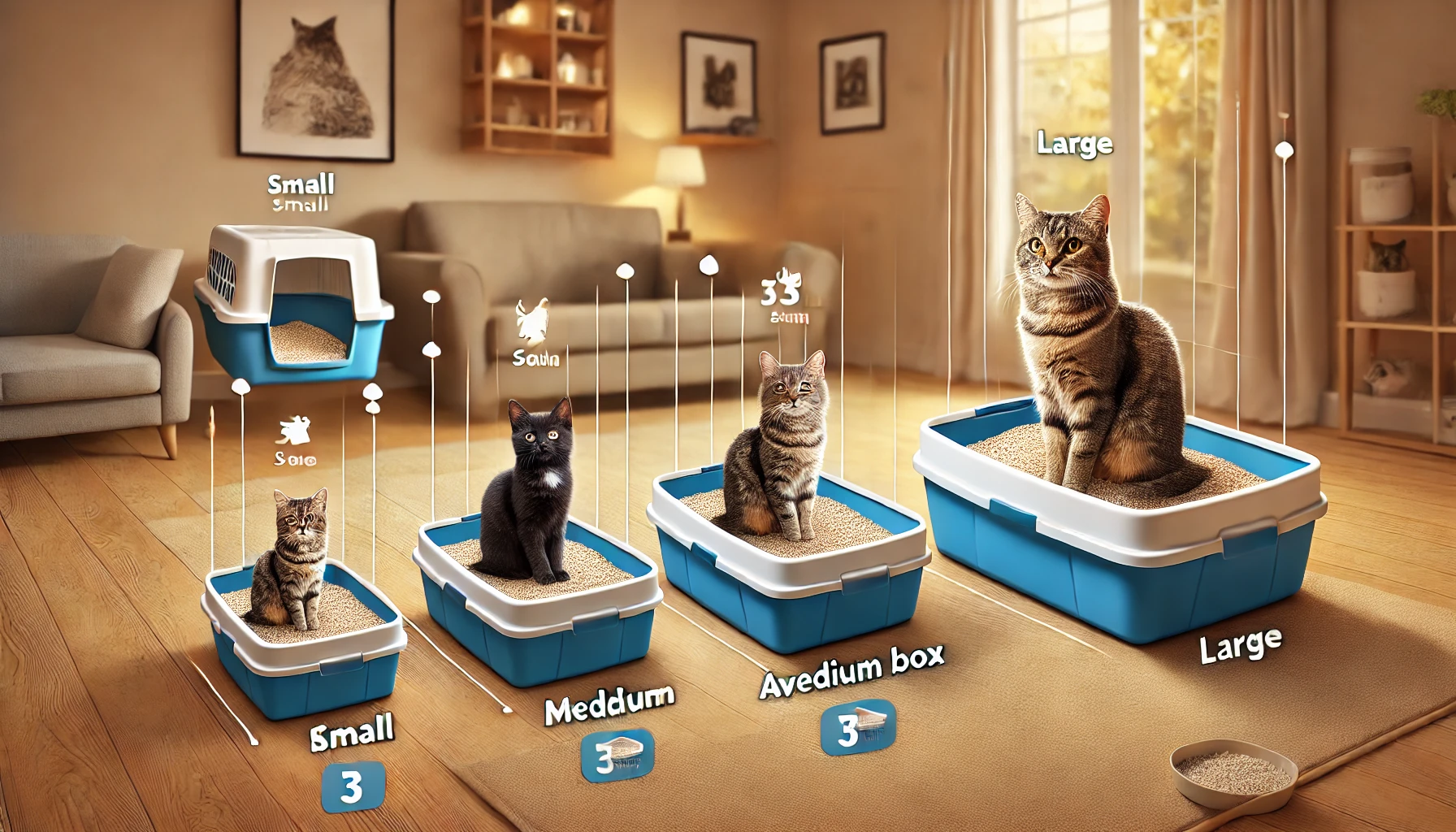
Size Matters: Finding the Right Fit for Your Cat
The size of the litter box is very important.
A box that is too small can make it difficult for your cat to use properly, leading to accidents outside the box.
Generally speaking, the litter box should be about one and a half times the length of your cat.
This provides them with enough room to move around and dig, as cats naturally do when using the litter box.
If you have a large or overweight cat, consider extra-large litter boxes designed for bigger breeds.
Kittens and older cats may also benefit from boxes with lower sides to make entry and exit easier.

Litter Box Placement: Where to Put It for Maximum Comfort
The location of the litter box can greatly affect your cat’s willingness to use it.
Cats prefer quiet, private areas where they won’t be disturbed while doing their business.
Avoid placing the litter box in high-traffic areas or near noisy appliances, as this could discourage your cat from using it.
It is also important to place the litter box in an accessible location.
If your home has multiple floors, consider placing a litter box on each level so your cat doesn’t have to travel too far when nature calls.
A well-placed litter box will encourage good habits and make cleaning easier for you.
It’s essential to consider your cat’s preferences when selecting a litter box. Whether your cat prefers open or covered litter boxes, always ensure it’s the right size and offers easy access.
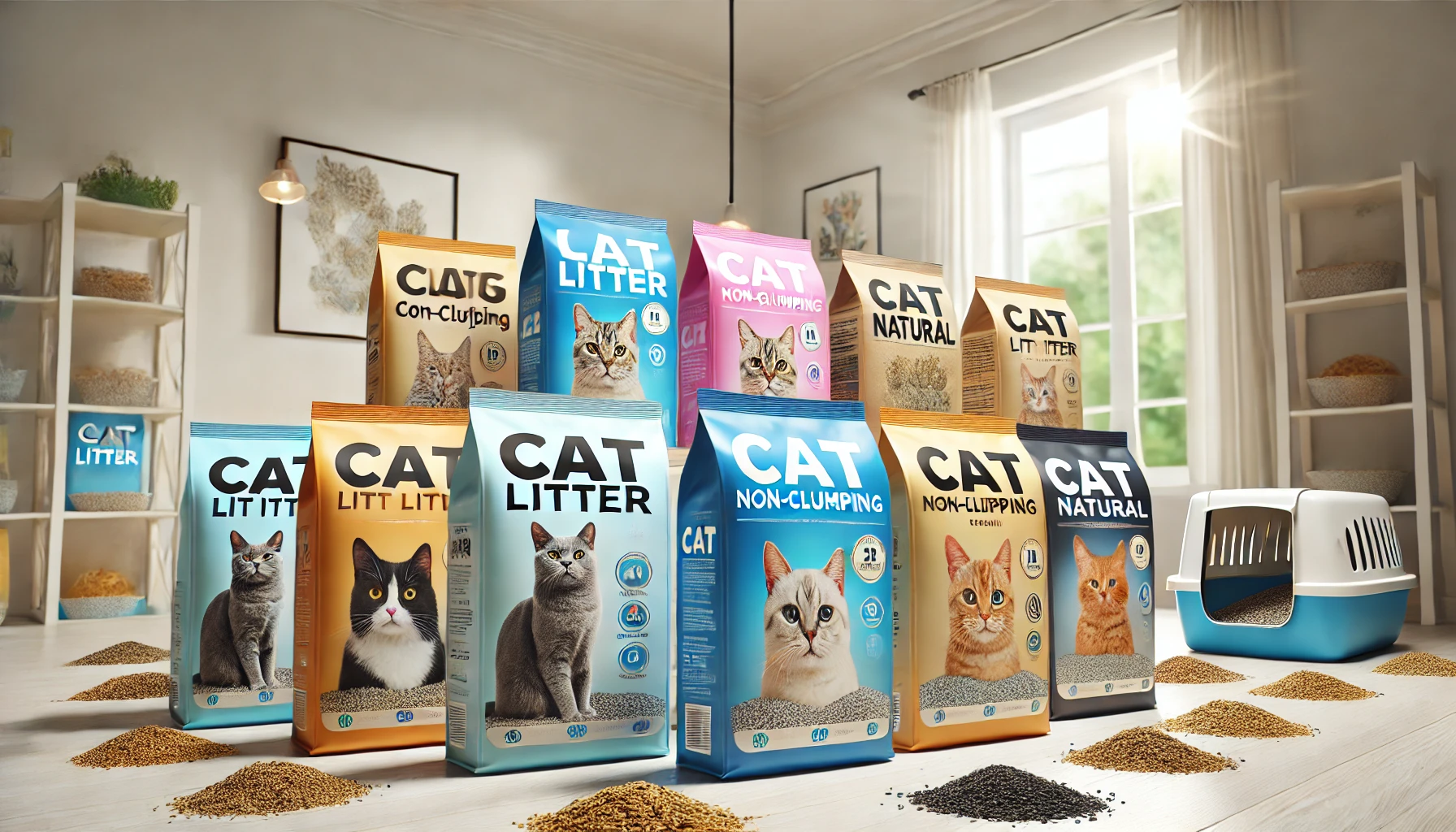
How to Choose the Best Cat Litter Available for Maximum Hygiene and Minimum Odor
Choosing the right cat litter is crucial not only for maintaining hygiene but also for preventing unpleasant smells.
With such a wide variety of options in the market, it can be tough to decide which type of litter is best suited for your cat and your home environment.
In this section, we will go into the details of all the prevalent options so you can make an informed choice to keep your cat’s litter box fresh and clean.
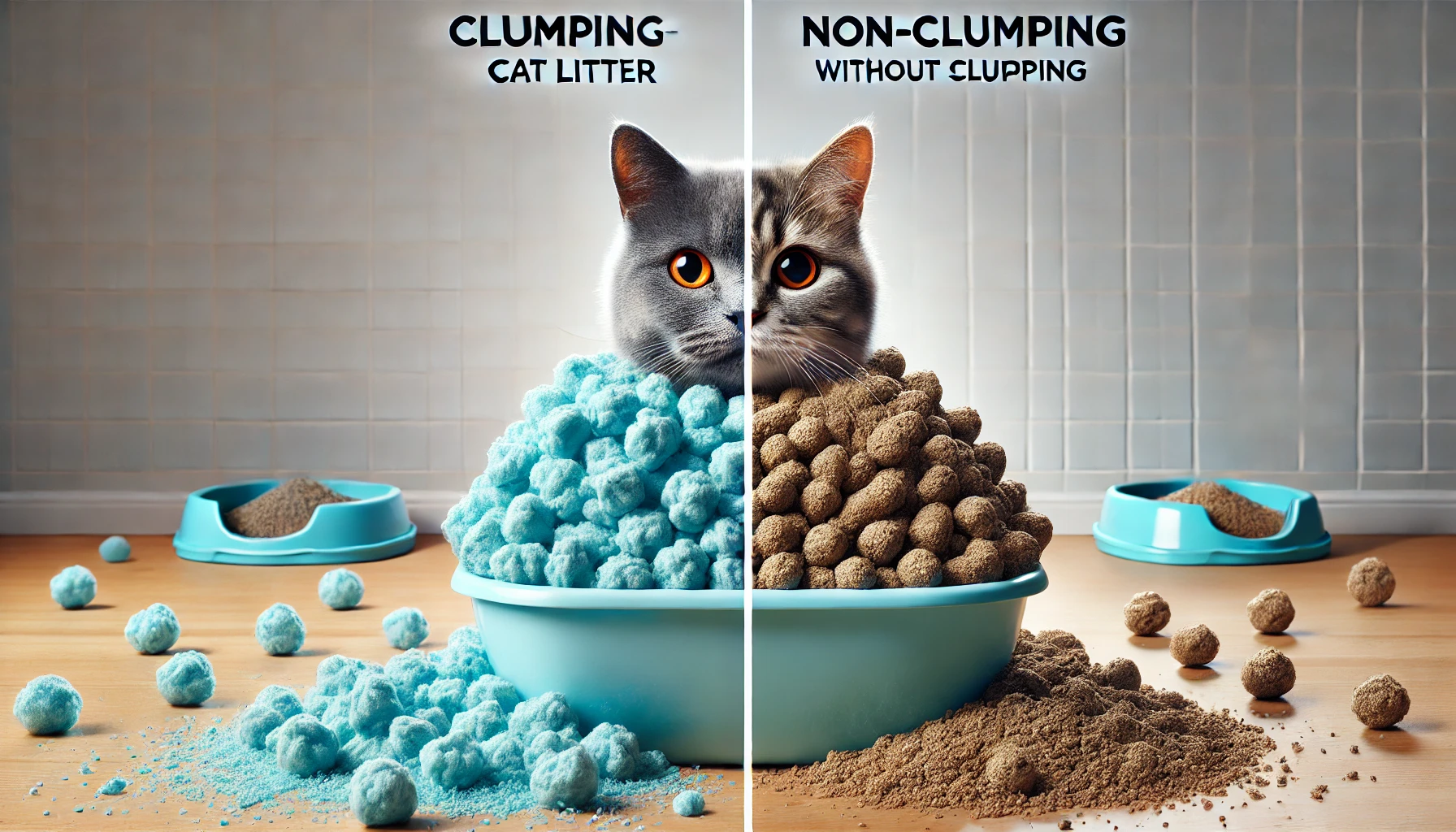
Clumping vs. Non-Clumping Litter: Which is Better?
The first decision you will need to make is between clumping and non-clumping litters.
Clumping litter is designed to form solid clumps when your cat urinates, making it easier to scoop out of the litter box.
This helps prevent spills or messes and reduces how often the litter needs to be fully changed.
For daily maintenance and odor control, clumping litter is generally easier for most owners to manage.
However, clumping litter can sometimes produce dust, which may not be ideal for cats or owners with respiratory sensitivities.
Non-clumping litter absorbs moisture but doesn’t form clumps.
As this type of litter doesn’t allow easy removal of all waste, it may need to be changed more frequently.
On the positive side, it tends to be less dusty, which might be better for kittens or cats with respiratory problems.
- Clumping Litter: Easier to scoop, better for odor control, but can be dusty.
- Non-Clumping Litter: Less dust, may be better for sensitive cats, but requires more frequent changes.

Natural vs. Synthetic Cat Litter: Pros and Cons
The next consideration is whether to choose natural or synthetic cat litter.
Natural litter, such as corn, wheat, or pine-based, is biodegradable and environmentally friendly.
It is also gentler on your cat’s paws and is ideal for eco-conscious pet owners.
On the downside, natural litter can be more expensive and may not mask odors as effectively as synthetic litter.
Synthetic litters, generally made from clay or silica gel crystals, are highly effective at reducing odors and are widely available.
However, they are not biodegradable and can harm the environment.
Additionally, some synthetic litters can be harsher on your cat’s paws, and if ingested during grooming, they may cause irritation.
- Natural Litter: Eco-friendly, biodegradable, gentle on paws, but may be more expensive with lower odor control.
- Synthetic Litter: Excellent odor control, inexpensive, but not eco-friendly and may cause irritation to your cat.
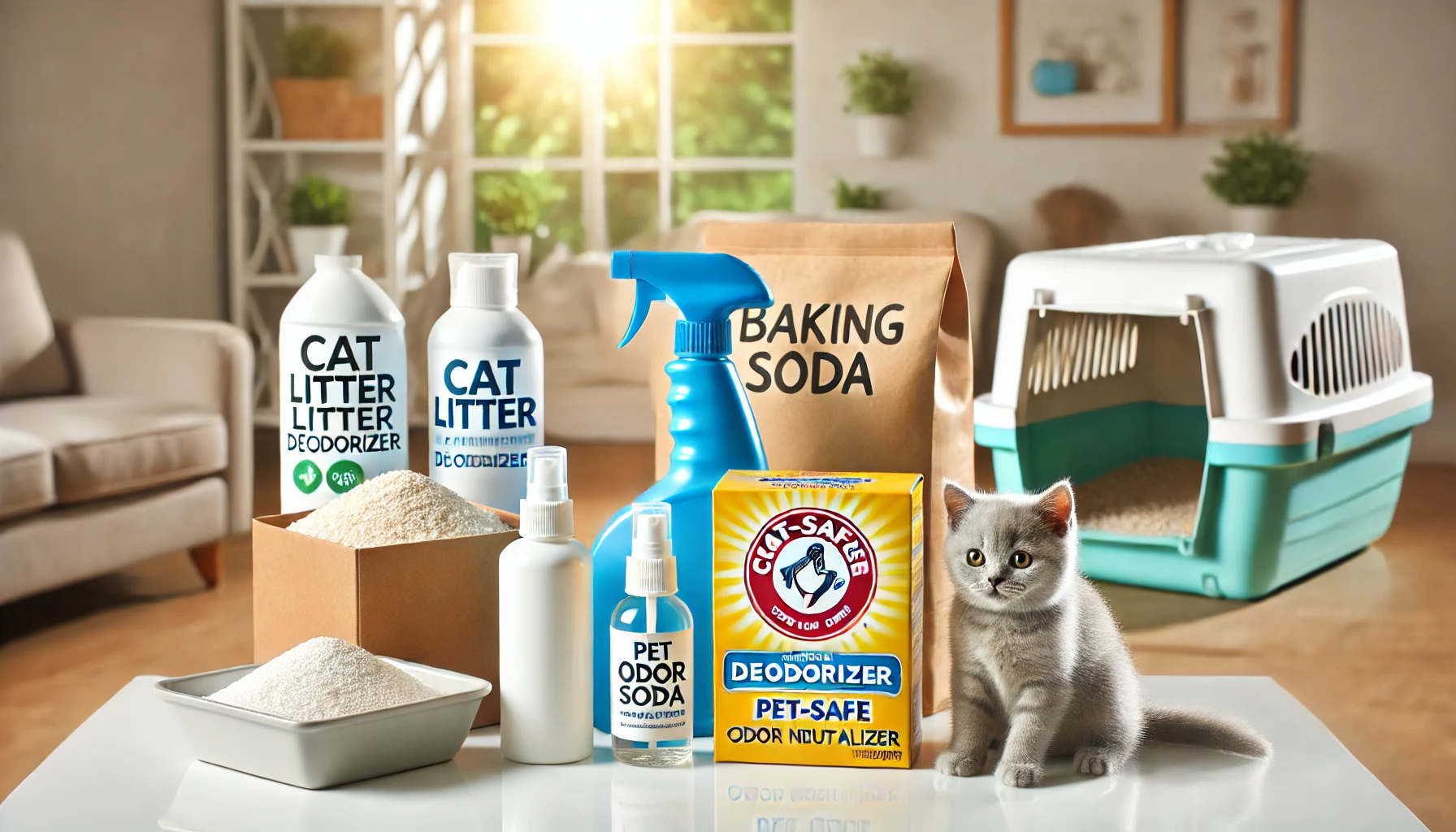
Odor Control Solutions: Maintaining the Freshness of the Litter Box
Maintaining a clean and odor-free litter box is essential for both your cat’s comfort and your home’s environment.
Here are a few tips to help keep unpleasant smells at bay:
- Deodorize your litter: Products like baking soda or cat litter deodorizers help neutralize odors.
- Choose a covered litter box: While open boxes allow better airflow, covered boxes help contain odors. Just ensure the covered box is placed in a well-ventilated area.
- Scoop regularly: Try to scoop the litter box at least once a day to prevent odor buildup.
- Replace litter as needed: Even with regular scooping, completely changing the litter every one to two weeks is essential for maintaining freshness.
By choosing the appropriate type of cat litter and following these tips for odor control, you can keep the litter box clean and comfortable for your feline friend while ensuring your home remains fresh and odor-free.
Choosing between clumping and non-clumping litters depends on ease of cleaning and personal preferences. Additionally, consider natural vs synthetic litters based on environmental impact and odor control.
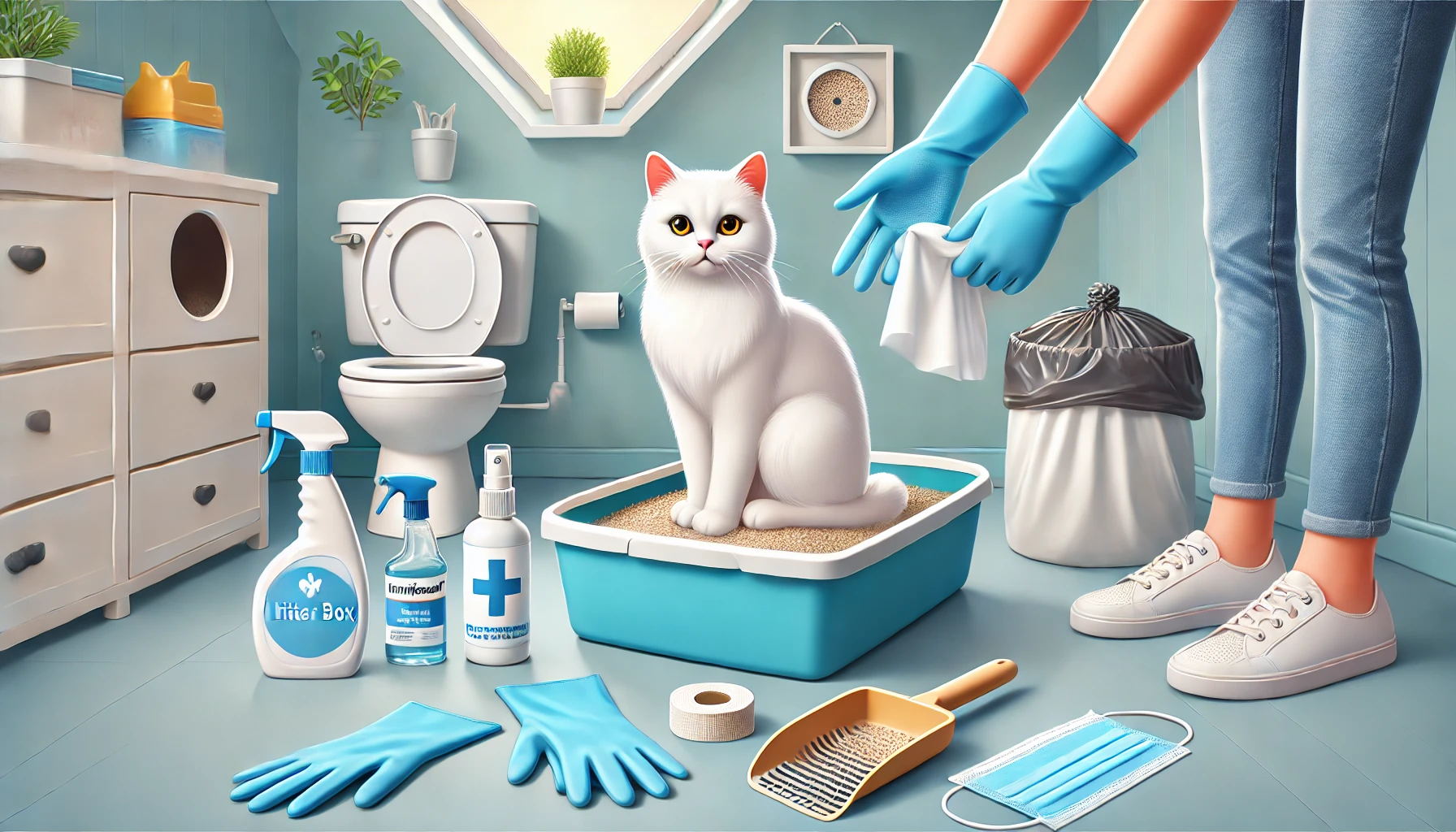
How to Clean a Cat’s Litter Box: A Step-by-Step Guide
Cleaning your cat’s litter box regularly is vital for ensuring a healthy environment for your pet.
It isn’t just about keeping it tidy; it’s also important because odors and bacteria can build up, causing possible infections or health problems for both your cat and household members.
In this section, we review step-by-step how to properly clean your cat’s litter box to keep it fresh and hygienic.
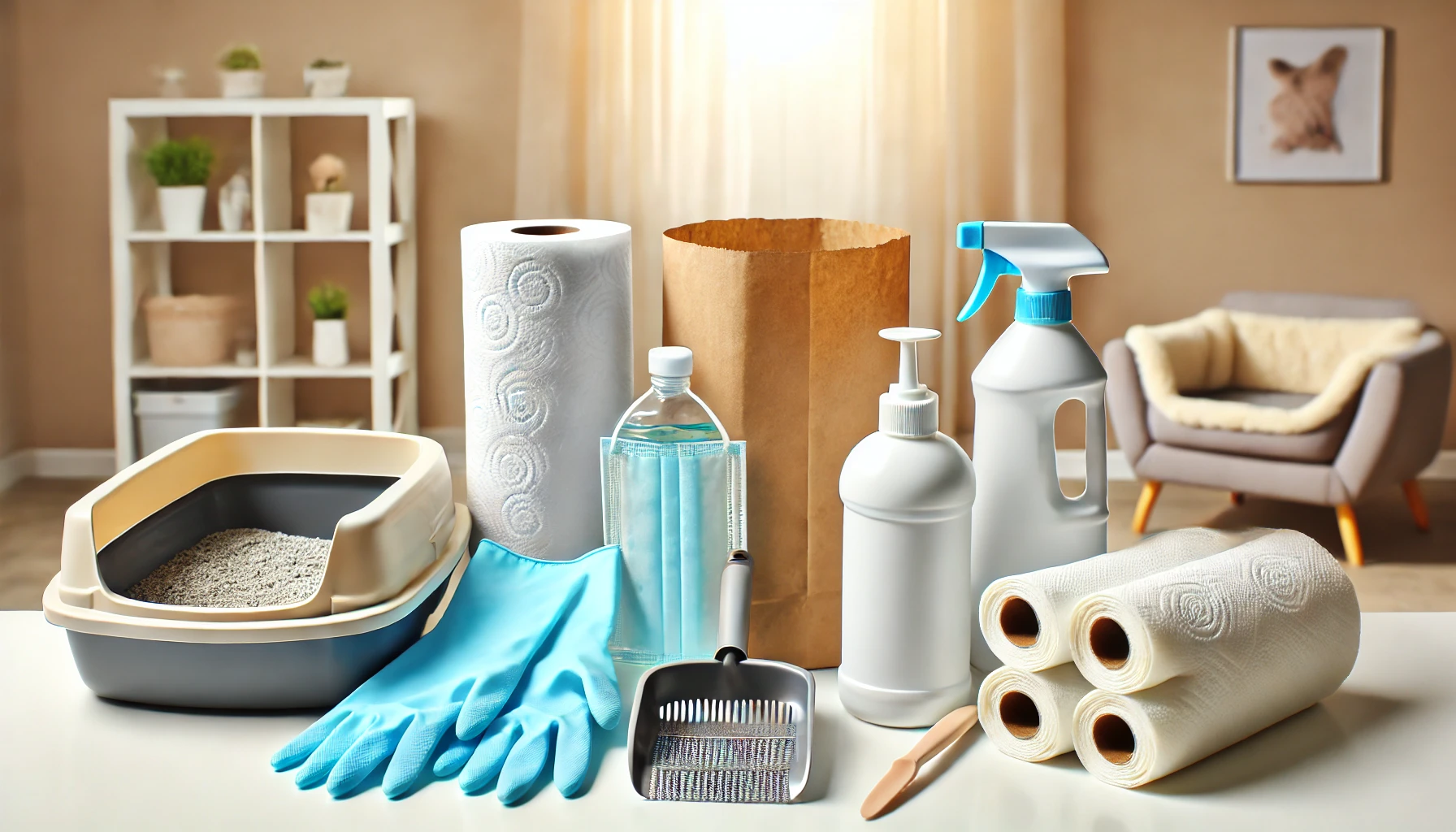
Gathering the Right Cleaning Supplies
Before you start, make sure you have all the necessary cleaning supplies.
Having the right tools will make the job faster and more efficient.
Here’s what you will need:
- Gloves: Always wear gloves when handling cat litter to protect yourself from bacteria and parasites like Toxoplasma gondii.
- Litter scoop: A sturdy scoop will help you easily remove clumps and waste from the litter box.
- Trash bags: Use heavy-duty trash bags to properly dispose of the waste.
- Disinfectant spray: Use a pet-safe disinfectant to clean and sanitize the litter box after removing the litter.
- Paper towels or cloth: For wiping down the litter box after applying disinfectant.
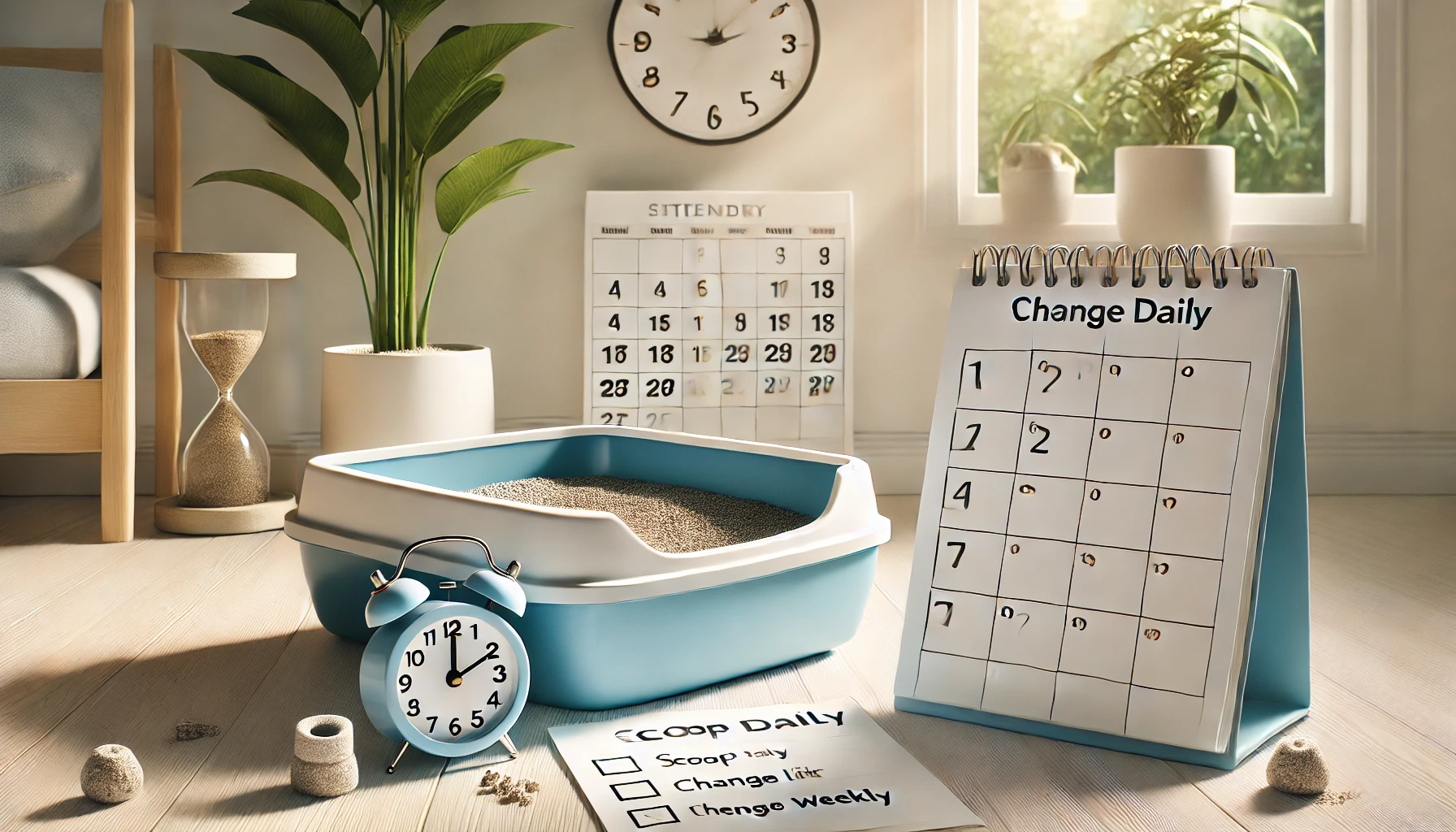
How Often to Clean the Litter Box?
The frequency of cleaning your cat’s litter box depends on the number of cats and the type of litter used.
A general rule is to scoop the litter box once or twice a day to remove clumps and waste.
This not only keeps the box clean but also helps with odor control.
The more cats you have, the more frequent the scooping should be.
Completely changing the litter should be done every week to ten days for clumping litter, and more frequently for non-clumping varieties.
This helps prevent bacteria buildup and ensures that your cat has a clean place to relieve themselves.
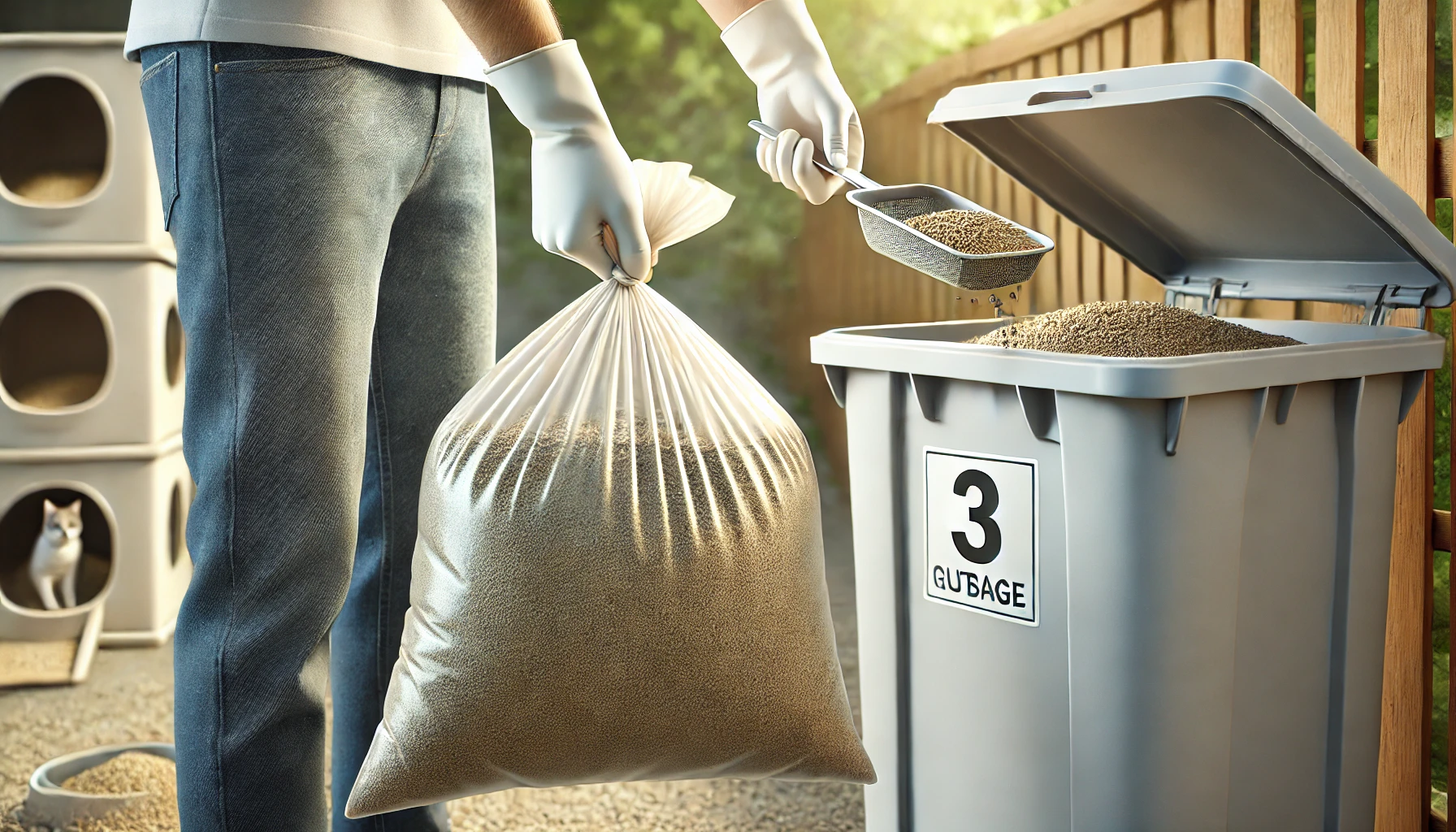
Disposal of Used Cat Litter
Proper disposal of used cat litter is important for both your health and the environment.
Never flush cat litter down the toilet, as it can cause plumbing blockages and introduce harmful bacteria like Toxoplasma gondii into water systems.
Here’s how to properly dispose of cat litter:
- Scoop the waste into a durable garbage bag and tie it tightly to prevent leaks and odors.
- Place the trash bag in an outdoor garbage bin to keep your home smelling fresh.
- If using biodegradable litter, consider composting it in a separate area away from edible plants, but always check local regulations before doing so.
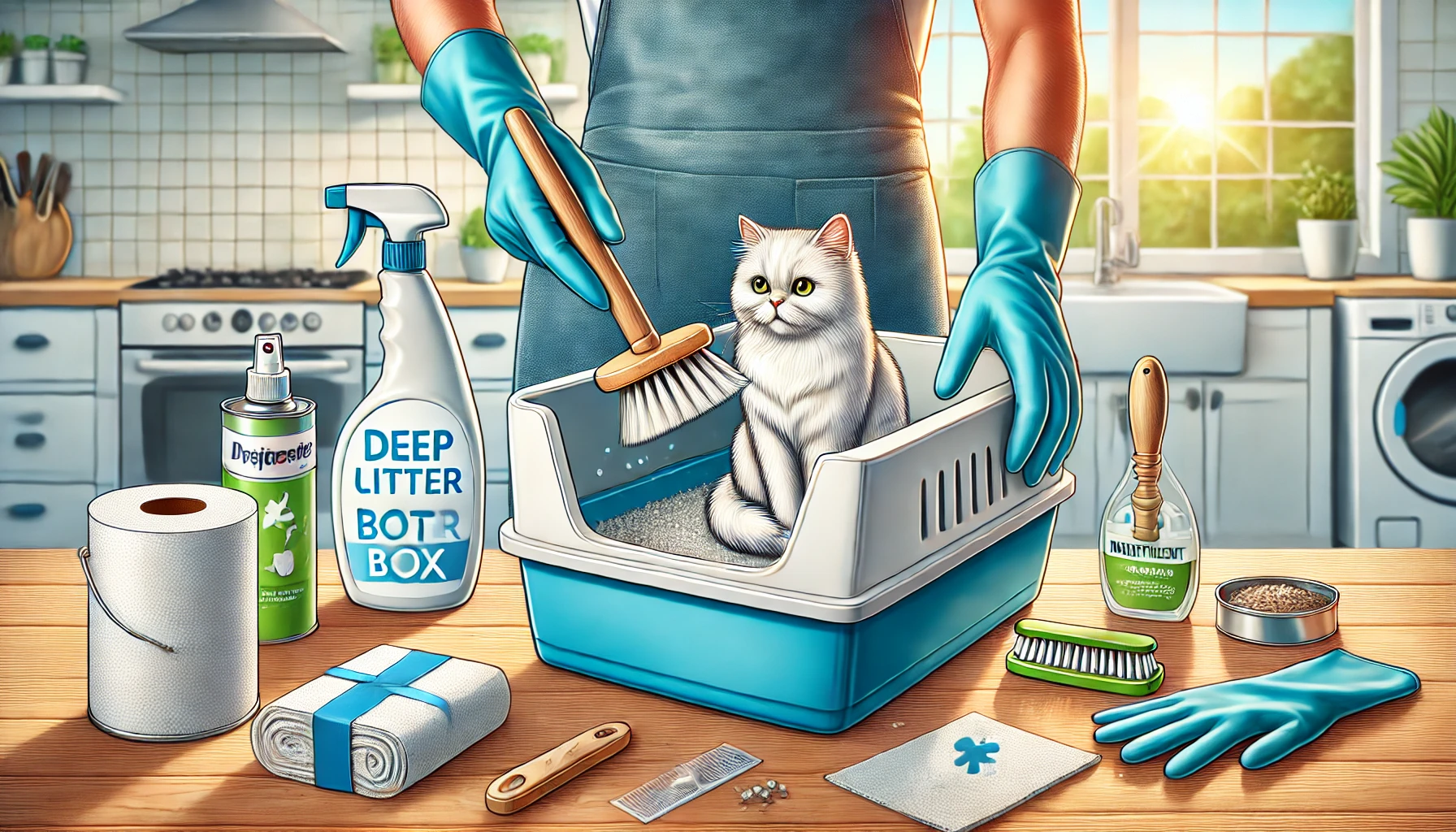
Deep Cleaning Tips: When and How to Scrub the Litter Box
Every month, or whenever you notice a lingering odor, it’s a good idea to deep clean your cat’s litter box.
Here’s how to do it effectively:
- Empty all the litter into a trash bag for disposal.
- Rinse the litter box with warm water to remove any remaining dust and debris.
- Spray the box with a pet-safe disinfectant, making sure to cover the entire surface, including corners.
- Let the disinfectant sit for a few minutes to kill any bacteria, then wipe it down with paper towels or a clean cloth.
- Once the box is completely dry, refill it with fresh litter and place it back in its original location.
By following these steps and maintaining a regular cleaning schedule, you can ensure that your cat’s litter box remains a safe, clean, and odor-free environment for your feline friend.
Regular cleaning is crucial to maintain hygiene and prevent infections. Always have the necessary cleaning supplies ready and establish a routine for efficient litter box cleaning.

Litter Box Hygiene to Keep Your Cat Healthy
Maintaining your cat’s litter box hygiene is directly related to their overall health and well-being.
A dirty litter box not only causes unpleasant odors but also attracts harmful bacteria and parasites that can lead to infections and serious health problems for your feline friend.
By following a regular cleaning routine and a few hygiene practices, you can easily keep your cat healthy and the area around the litter box safe.
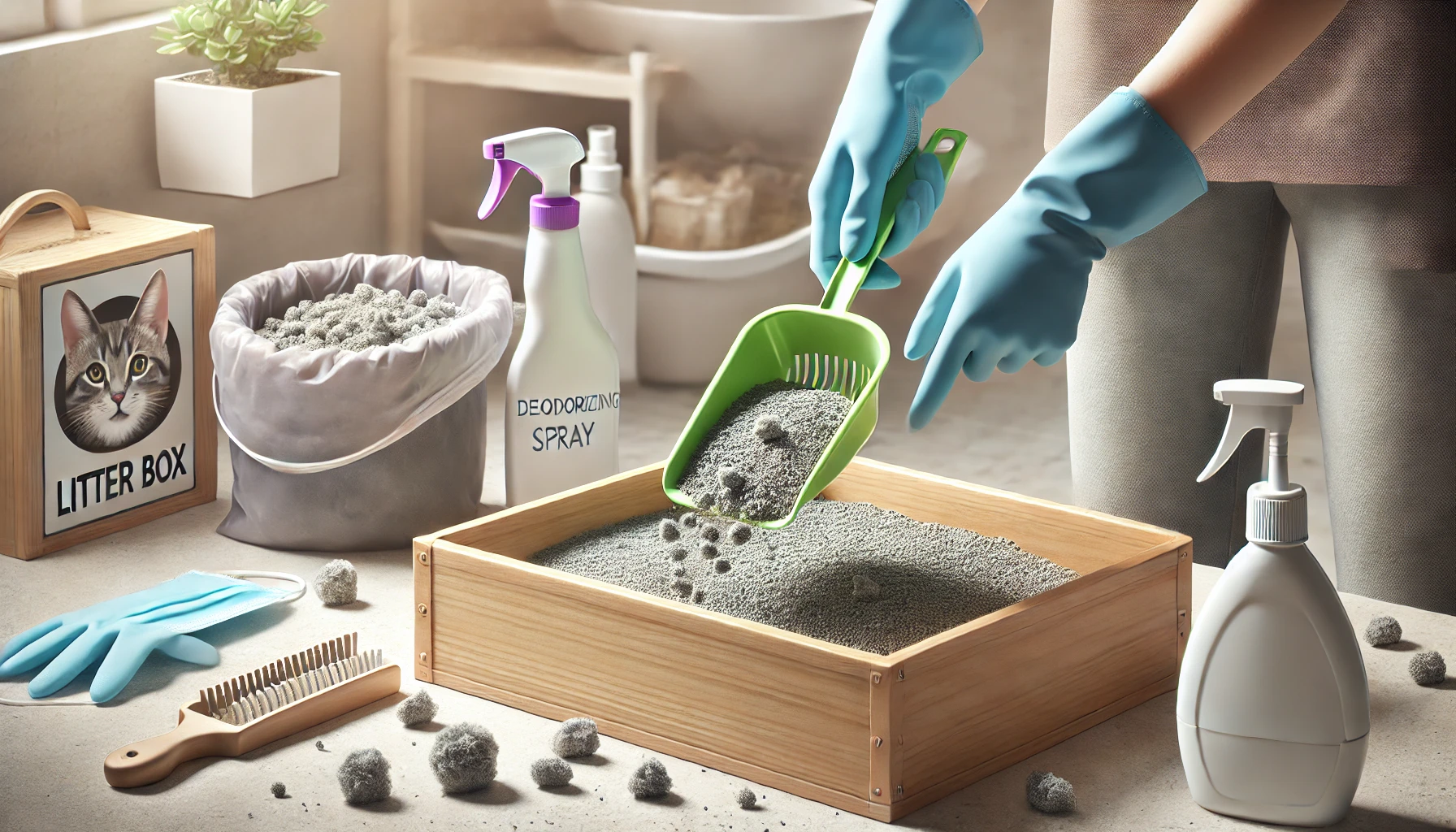
Daily Care Routine for a Hygienic Litter Box
Daily maintenance of your cat’s litter box is one of the best ways to ensure it stays clean and hygienic.
Here’s what you can do on a day-to-day basis:
- Scoop regularly: Scoop the litter box once or twice a day to remove solid waste and clumps. This helps prevent odors and reduces bacterial growth in the litter.
- Check for mess: Ensure that there is no litter spillage over the edges of the box. Clean up any stray litter to maintain a tidy area around the litter box.
- Stir the litter: Stirring the litter helps distribute moisture evenly, preventing clumps from sticking to the sides of the box.
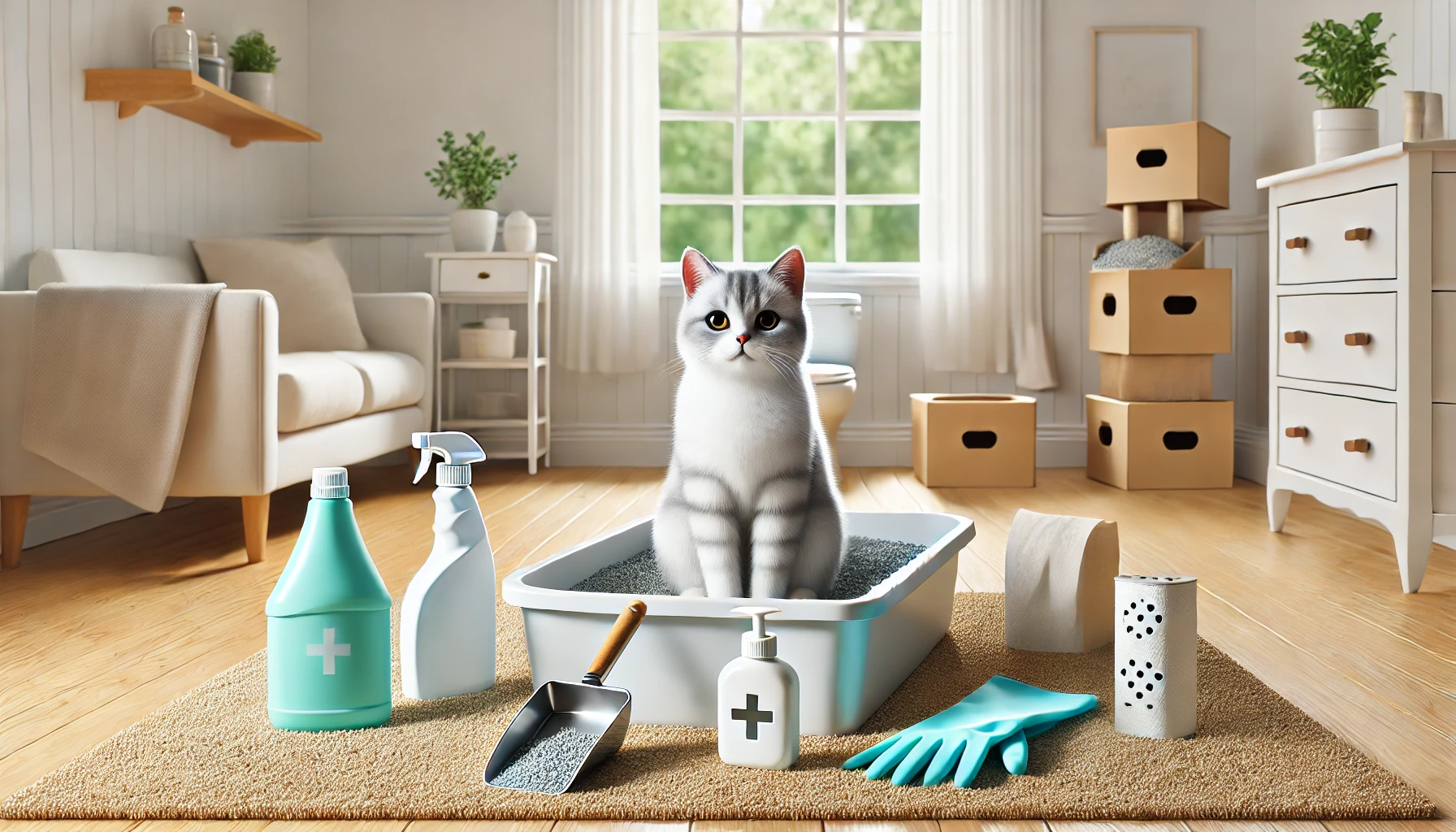
Preventing Infections and Health Issues from a Dirty Litter Box
A dirty litter box can lead to a variety of health issues for your cat, including urinary tract infections (UTIs), respiratory problems, and even behavioral issues.
Cats may avoid using a litter box if it becomes too dirty, leading to accidents around your home.
To prevent these health problems, it’s essential to maintain proper litter box hygiene by:
- Regular cleaning: Stick to a regular cleaning schedule to keep the litter box fresh and free of harmful bacteria.
- Providing enough litter boxes: If you have multiple cats, provide one litter box per cat, plus one extra. This helps prevent overcrowding and reduces hygiene issues.
- Selecting the right type of litter: Use a high-quality, odor-controlling litter that your cat prefers and that minimizes bacterial growth.
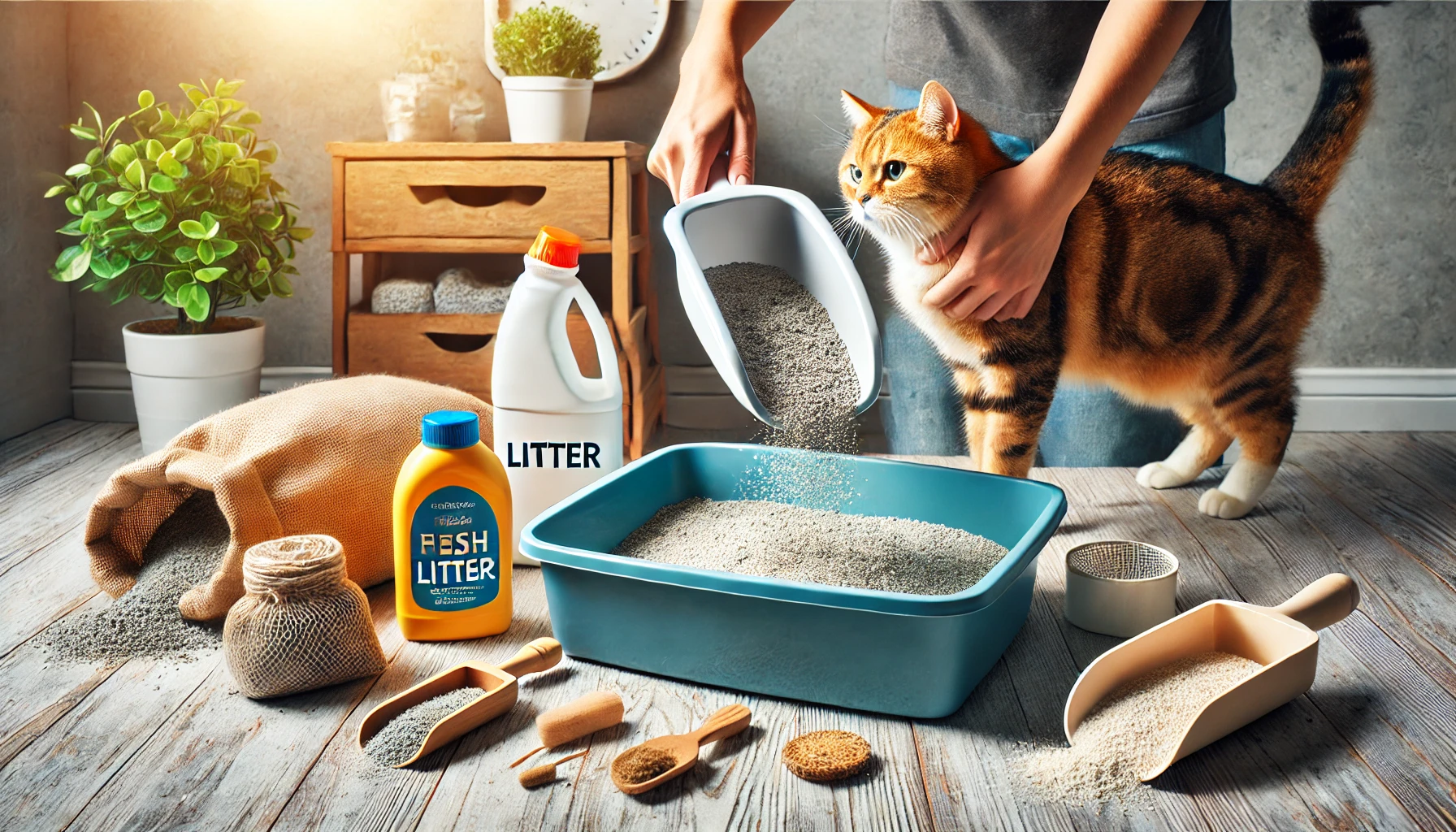
Importance of Regular Litter Replacement
Even with daily scooping, it’s important to fully replace the litter at least once a week for clumping litter and more frequently for non-clumping varieties.
Over time, bacteria and odors build up, creating an unhealthy environment for your cat.
Here are a few tips for proper litter replacement:
- Dump old litter completely: Don’t just top it off. Empty the entire litter box to remove any accumulated bacteria.
- Clean the box: After removing the litter, clean the box thoroughly with warm water and a pet-safe disinfectant before refilling it with fresh litter.
- Use enough litter: Ensure the litter box is filled with at least 2-3 inches of litter to allow your cat to properly bury their waste.
By maintaining a consistent cleaning routine, you can ensure your cat stays healthy and reduce the risks associated with poor litter box hygiene.
A fresh and well-maintained litter box will also encourage good behavior and keep your cat feeling happy and comfortable.
Poor hygiene in the litter box can lead to health problems like UTIs and respiratory infections. Clean regularly to avoid these risks and ensure your cat’s well-being.
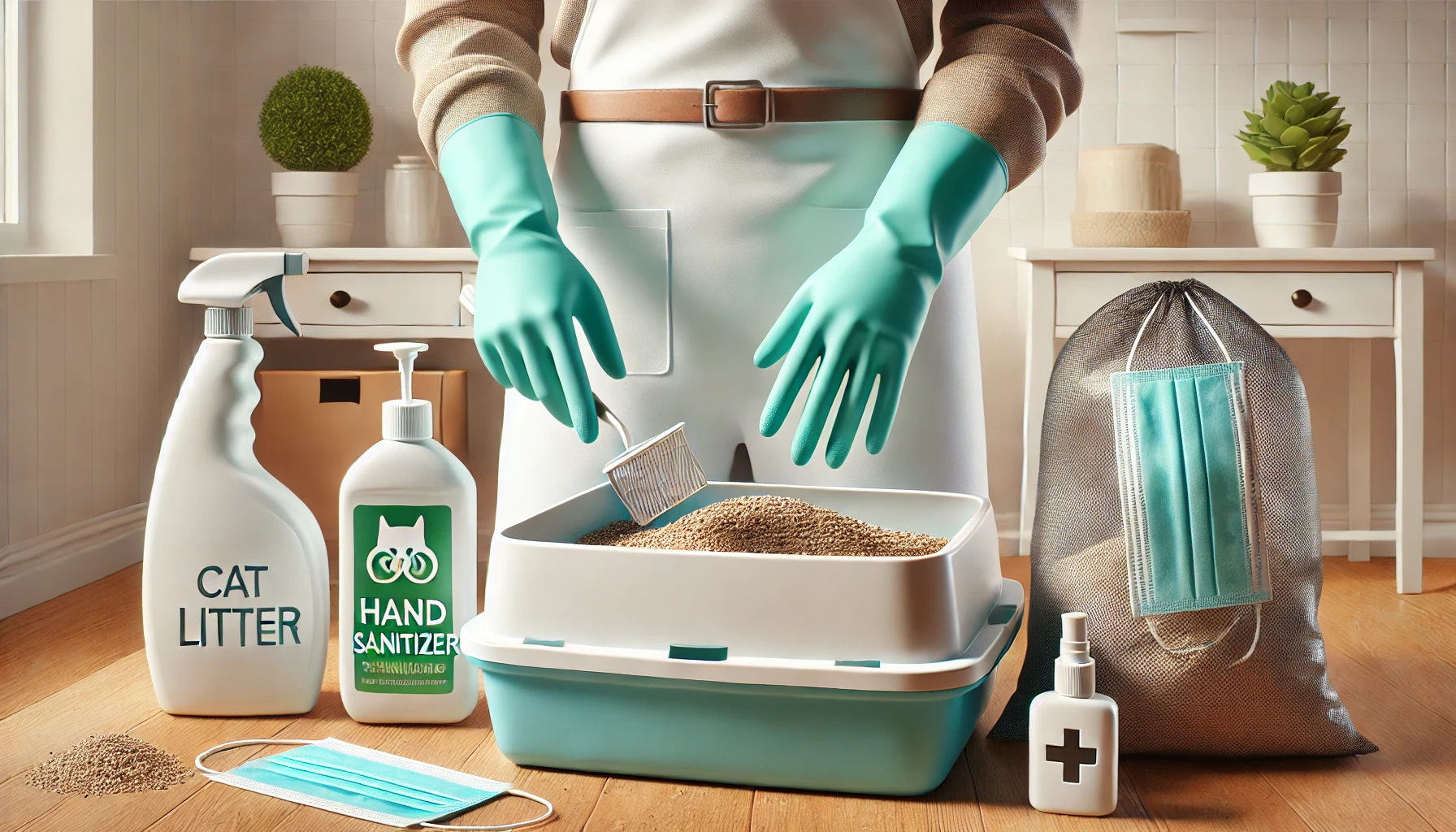
Safety Tips for Cleaning and Handling Cat Litter
Cleaning your cat’s litter box is not only a matter of hygiene but also of handling the litter safely to protect both you and your pet.
Poorly managed cat litter can expose you to bacteria, parasites, and even chemicals.
By following a few precautions, you can minimize health risks while keeping your cat’s litter box clean and fresh.
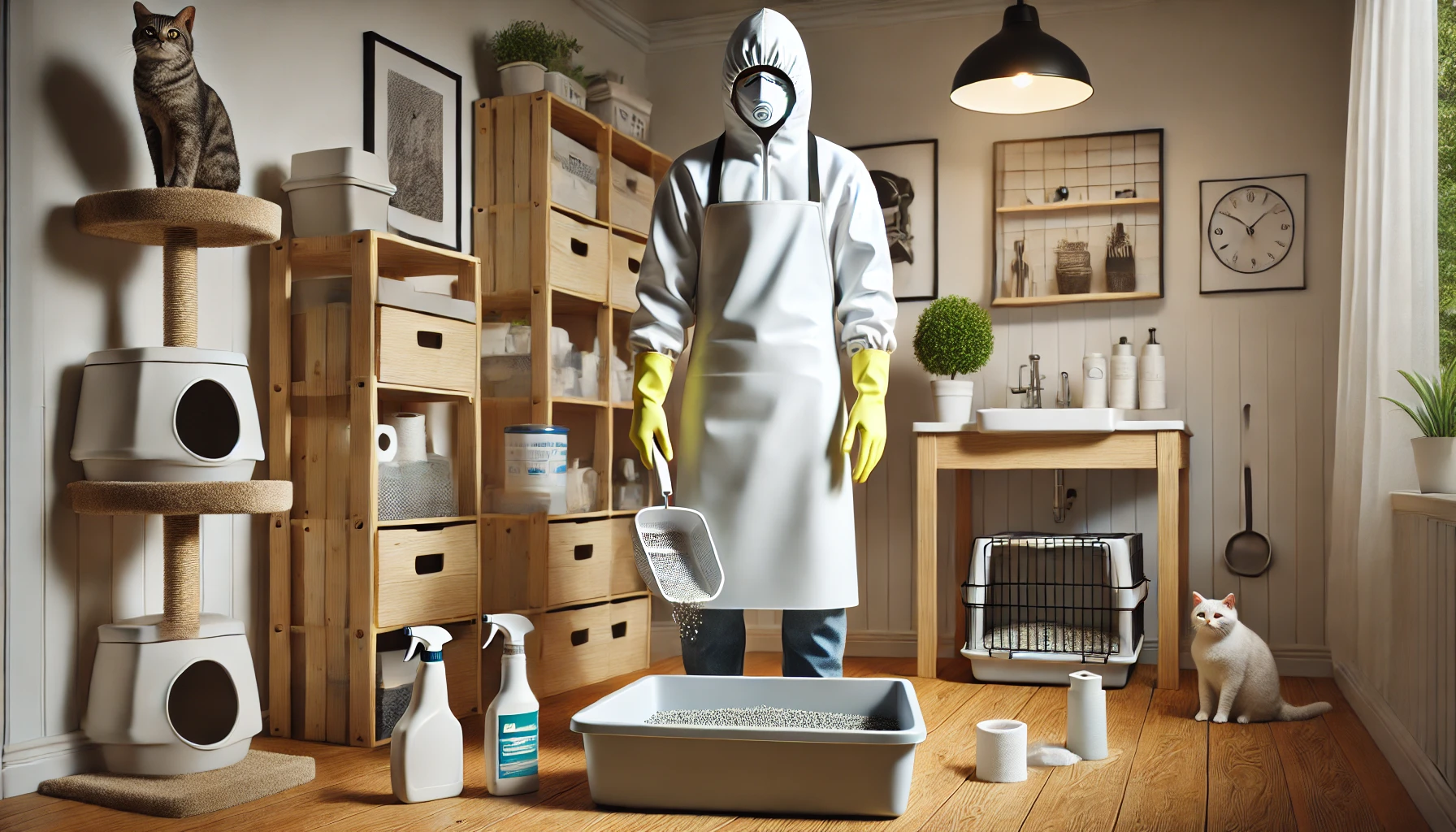
Wearing Protective Gear While Cleaning
When cleaning the litter box, wearing protective gear is important to avoid direct contact with waste and harmful microorganisms, including the parasite Toxoplasma gondii, which can cause diseases in humans.
Here’s what you should wear while cleaning:
- Gloves: Protect your skin from bacteria and parasites by wearing either disposable or washable gloves when handling any type of cat litter.
- Mask: If you are sensitive to dust, especially from clumping or clay-based litters, wearing a mask can prevent dust particles from entering your lungs.
- Apron or old clothes: Wear clothes you don’t mind getting dirty, as litter dust or waste may spill during cleaning.
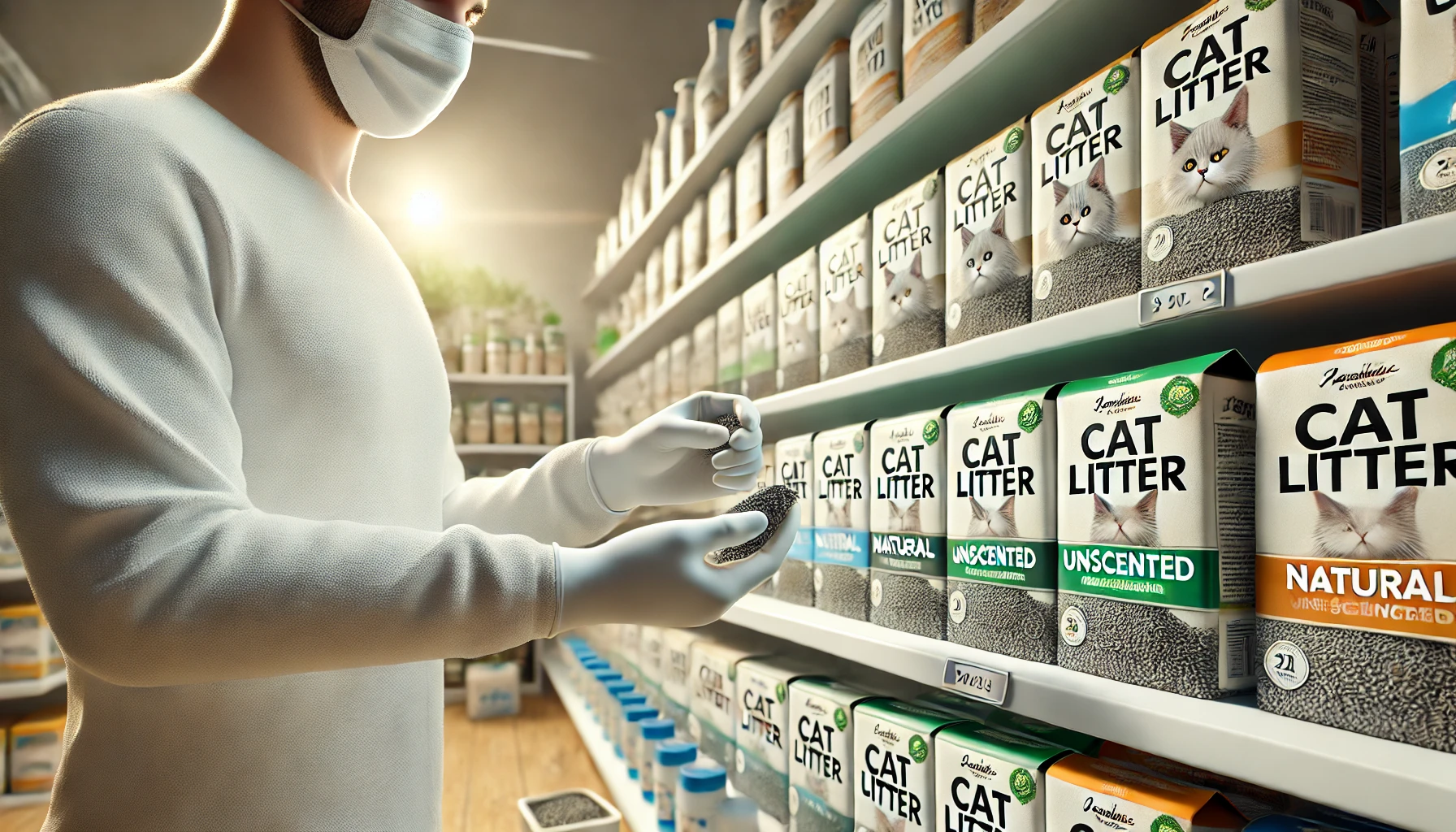
Minimizing Exposure to Harmful Chemicals in Cat Litter
While many cat litters are non-toxic, some may contain chemicals that can become airborne in the form of dust.
Litters with fragrances or deodorizers can irritate the respiratory system.
Here are some tips to reduce exposure to harmful chemicals:
- Use unscented natural litters: Opt for natural cat litters made from corn, wheat, or recycled paper. These are safer for both you and your cat and are less likely to cause irritation.
- Avoid artificial deodorizers: Steer clear of heavily scented cat litters. While they may help mask odors, they can irritate your cat’s sensitive nose and potentially cause respiratory problems.
- Ventilate the area: Ensure the room where the litter box is placed is well-ventilated to reduce the buildup of dust and chemical fumes.
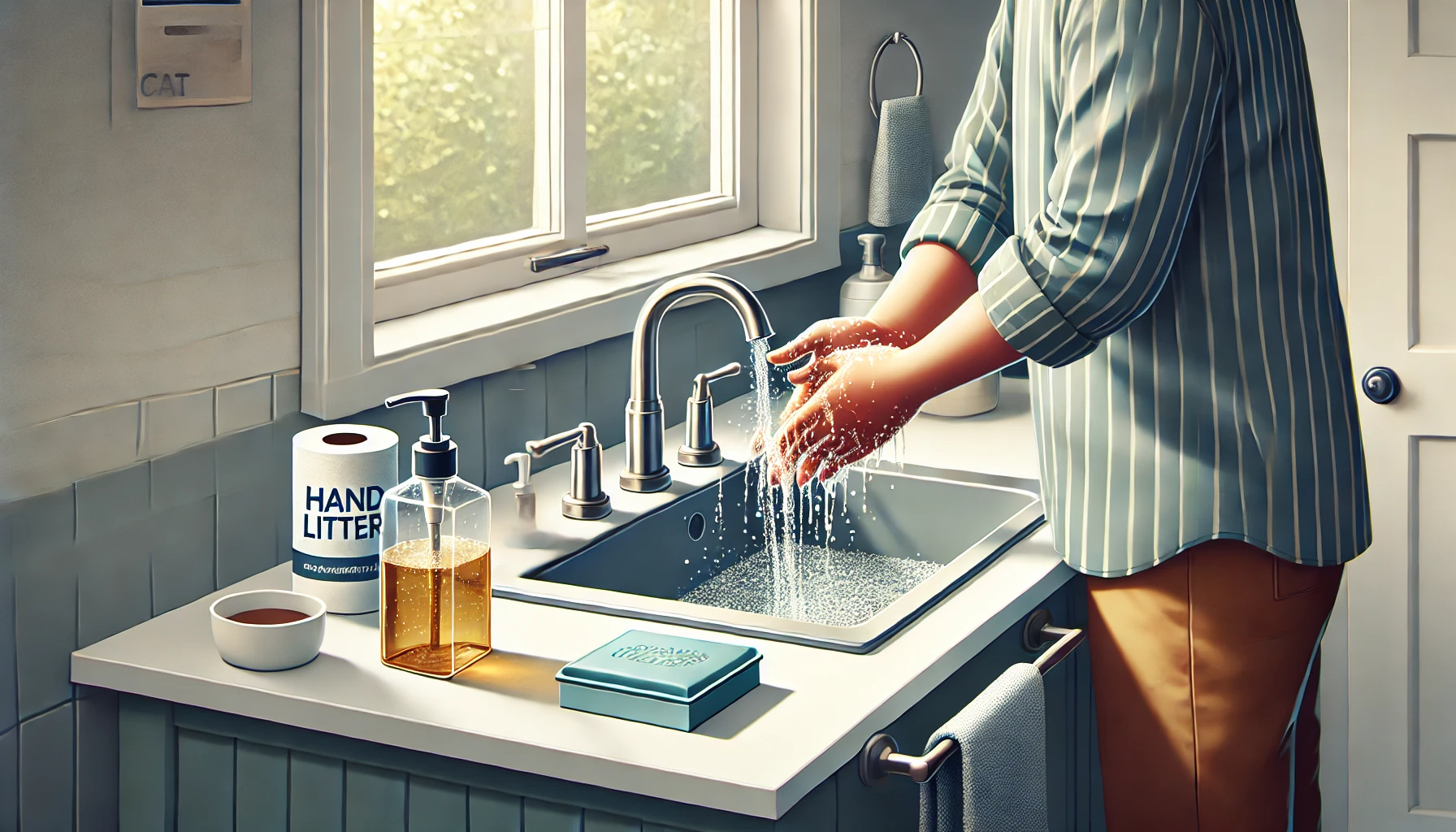
How to Properly Wash Your Hands After Handling Cat Litter
After cleaning your cat’s litter box, washing your hands thoroughly is crucial to remove any bacteria or parasites you may have come in contact with.
Here’s how to properly wash your hands:
- Use soap and water: Wash your hands with warm water and soap, scrubbing between your fingers and under your nails for at least 20 seconds.
- Hand sanitizer: If soap and water are not available, use a hand sanitizer with at least 60% alcohol to disinfect your hands.
- Avoid touching your face: While handling litter, avoid touching your face, especially your mouth, eyes, and nose, to prevent the spread of bacteria or parasites.
By following these safety tips and precautions, you can safely handle your cat’s litter box and minimize the risks associated with cleaning and disposal.
These steps will help protect both you and your feline friend from potential health hazards.
Always wear protective gear when cleaning the litter box to avoid exposure to harmful bacteria or parasites. Regular hand washing and proper disposal methods are essential.
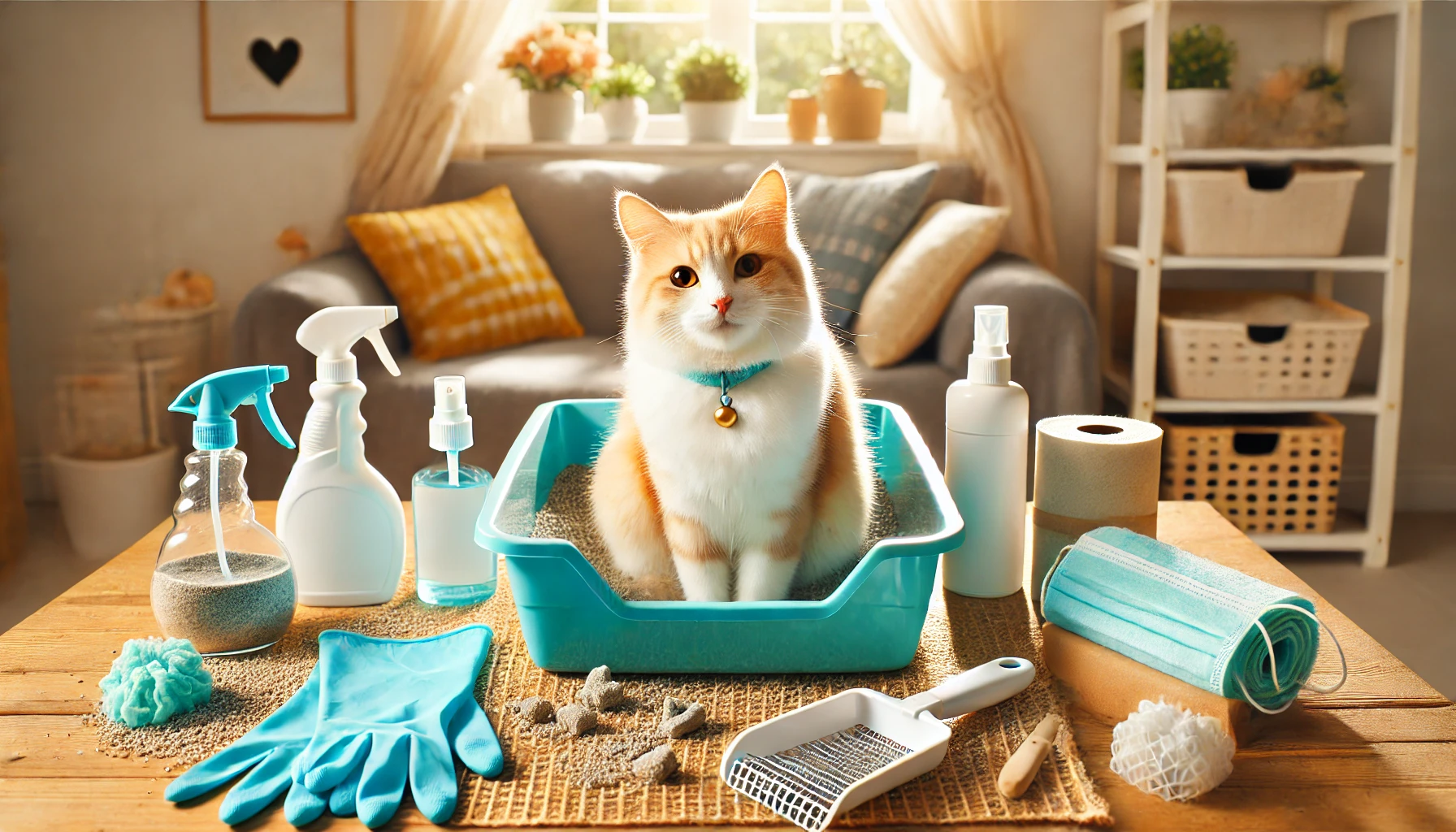
Conclusion: How to Ensure Your Cat Has a Hygienic and Secure Litter Box
One of the key responsibilities of cat owners is maintaining cleanliness and hygiene in the litter box.
This not only guarantees that your home remains free of unpleasant odors but also ensures that your cat stays healthy.
By selecting the right cat litter, establishing a regular cleaning routine, and following essential safety precautions, you can create a comfortable and secure environment for your cat.
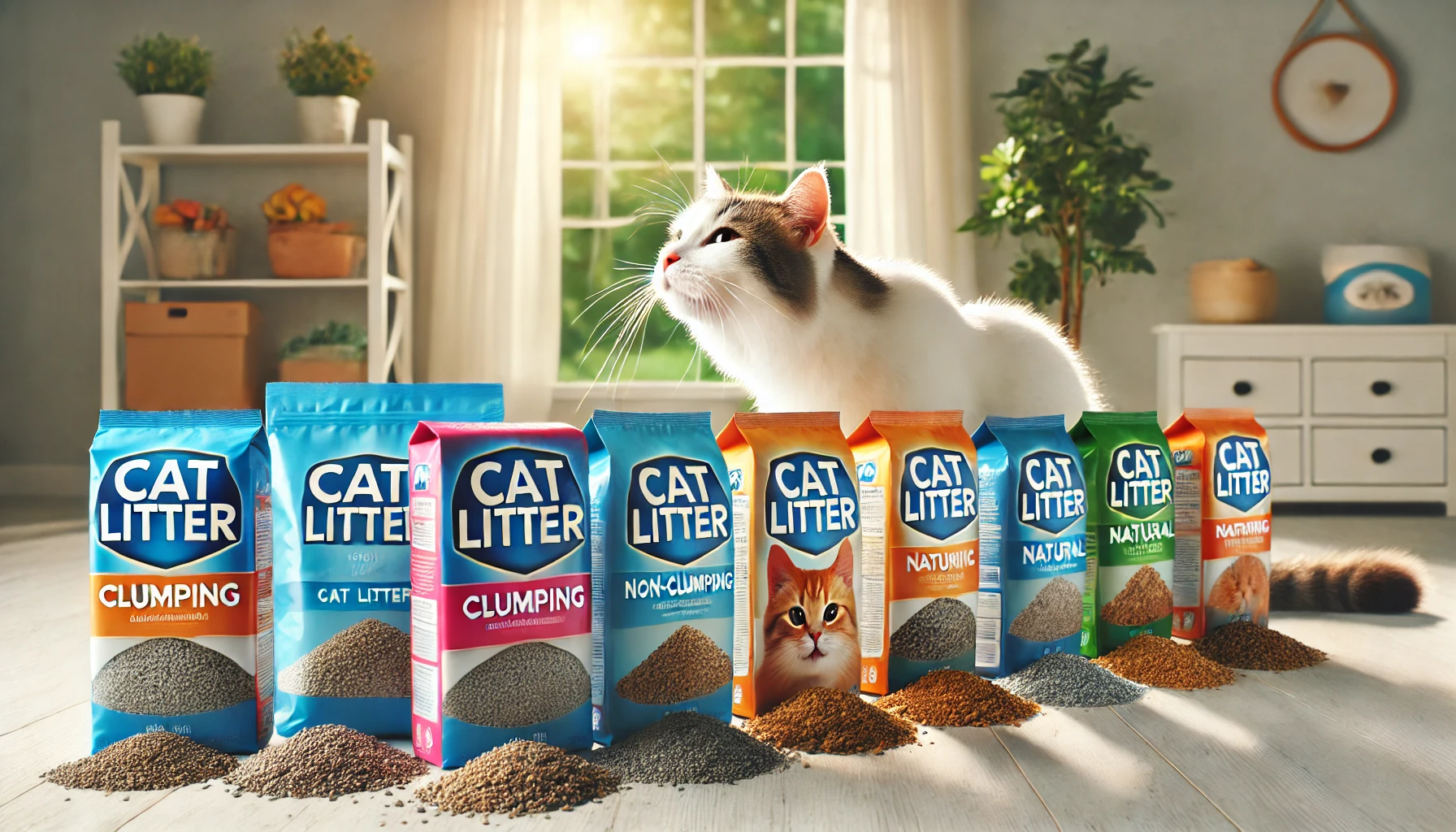
The Importance of Choosing the Right Litter
Choosing the right cat litter is essential for maintaining both hygiene and odor control.
Clumping and non-clumping litters each have their advantages, and selecting the right one will make cleaning much easier.
Moreover, opting for natural, unscented litters can reduce respiratory irritation for both you and your cat, while also promoting a safer environment.
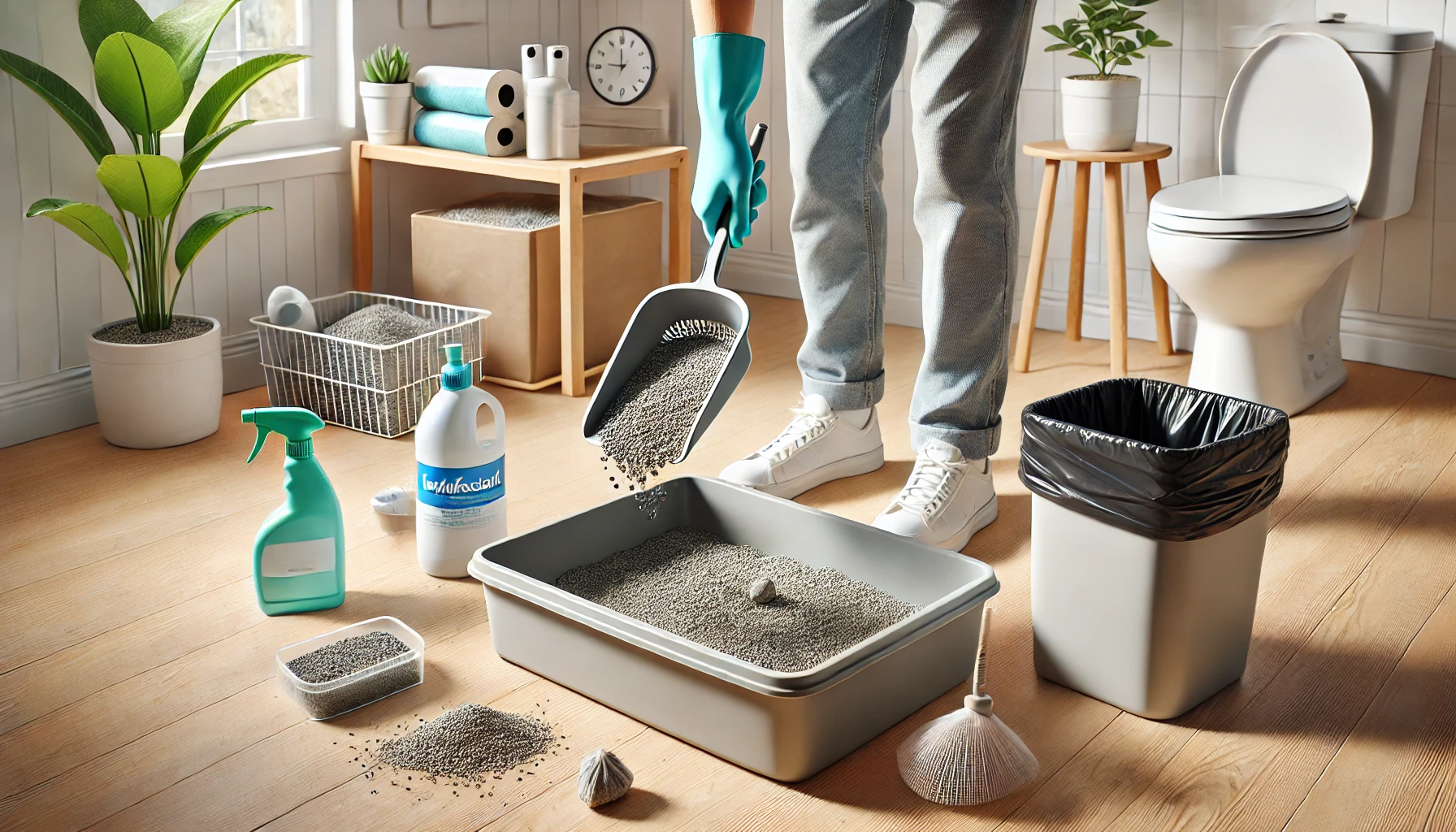
Daily Cleaning of the Litter Box
A clean litter box begins with a consistent daily routine.
Scooping the litter box once a day, checking for spills, and stirring the litter regularly can help minimize odors and bacterial growth.
This simple daily maintenance ensures the litter box remains a welcoming place for your cat, while reducing potential health risks.
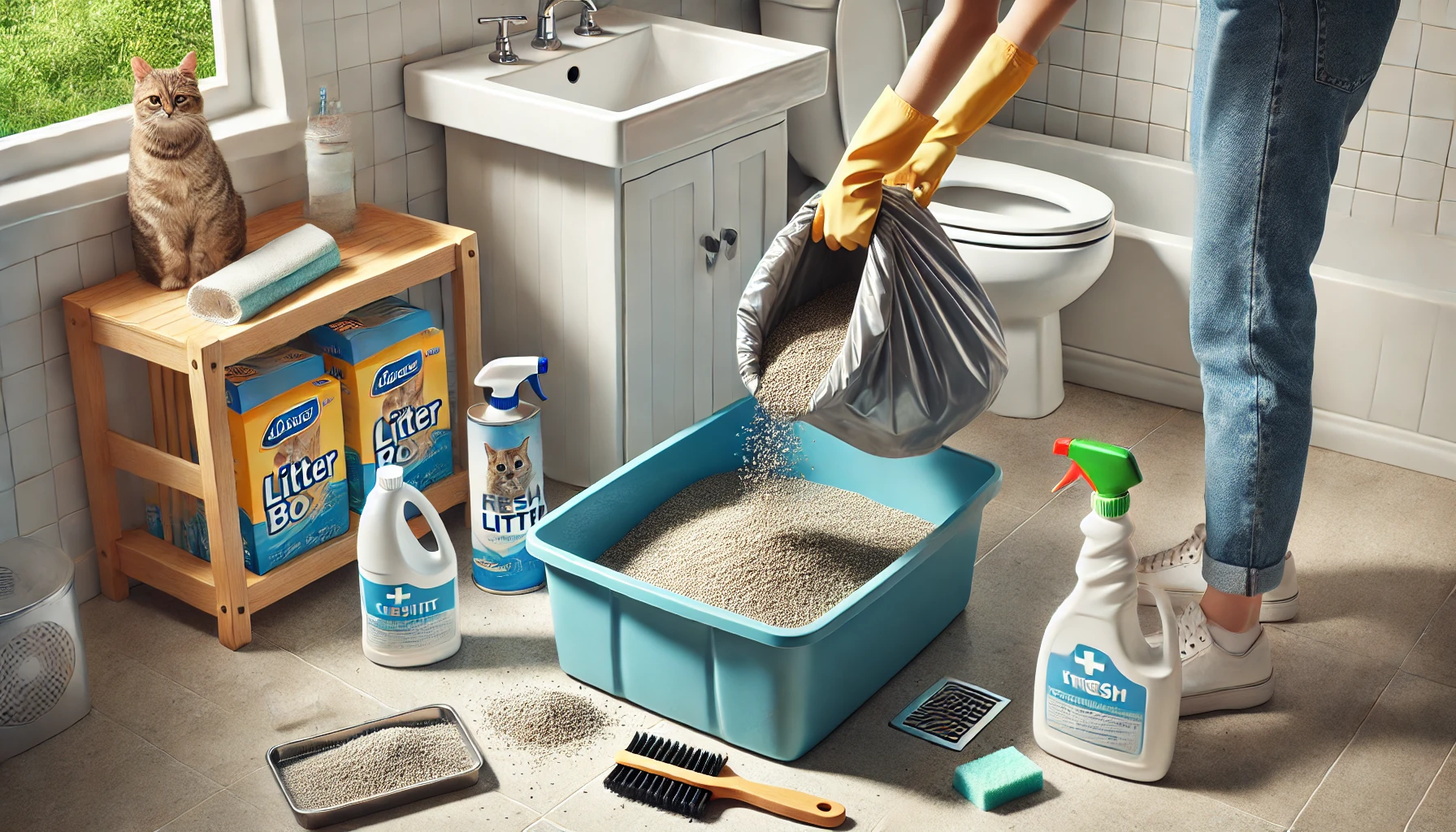
Deep Cleaning and Replacing the Litter Regularly
In addition to daily scooping, it’s important to regularly change the litter.
Deep cleaning the litter box every few weeks and replacing all the litter helps eliminate bacteria and bad odors.
Using a pet-safe disinfectant and following proper disposal methods will keep the litter box fresh and hygienic for your cat.
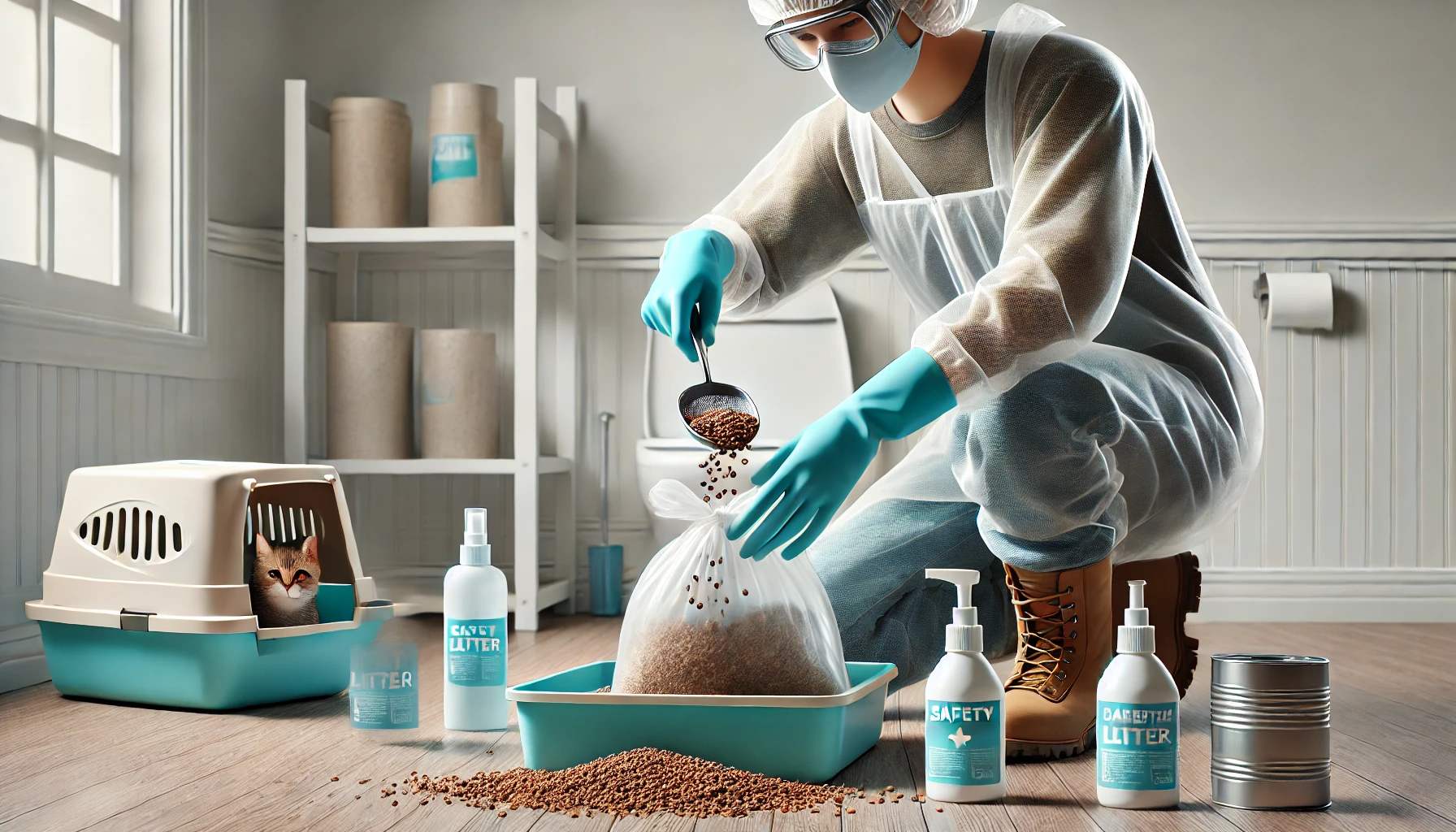
Safety First: How to Handle Cat Litter with Care
Handling cat litter safely is essential to protect yourself from potential health hazards.
Wearing gloves while cleaning the litter box, using a mask if needed, and thoroughly washing your hands afterward can help prevent exposure to harmful bacteria and parasites.
Using natural, unscented litters and placing the litter box in a well-ventilated area will also reduce the risk of chemical exposure.
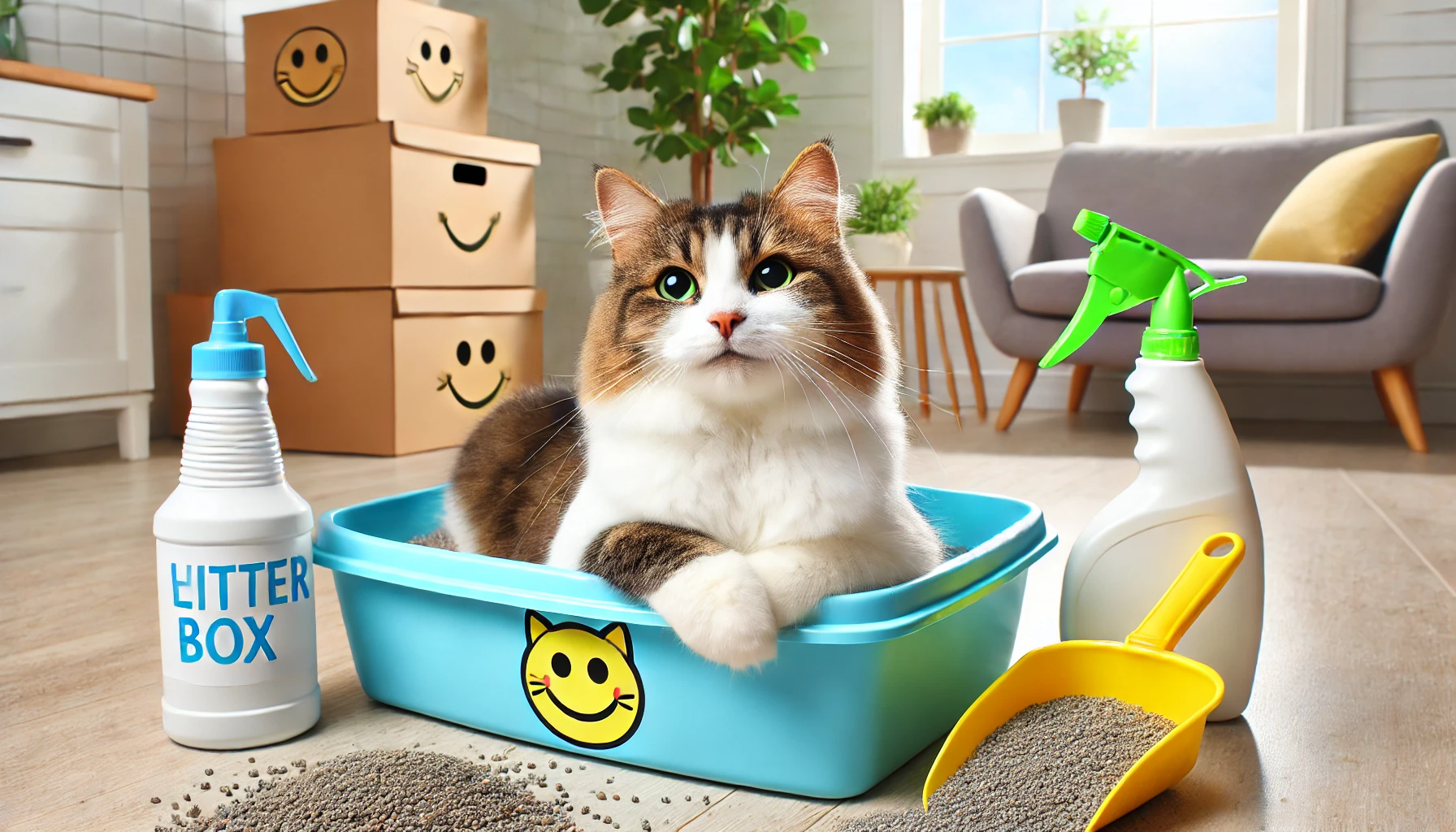
A Healthy Litter Box Equals a Happy Cat
A clean and hygienic litter box benefits both you and your cat.
A healthy environment promotes good behavior, reduces stress, and helps prevent issues such as infections or respiratory problems.
By following these simple steps, you can ensure your cat’s health and happiness, while keeping your home clean and fresh.
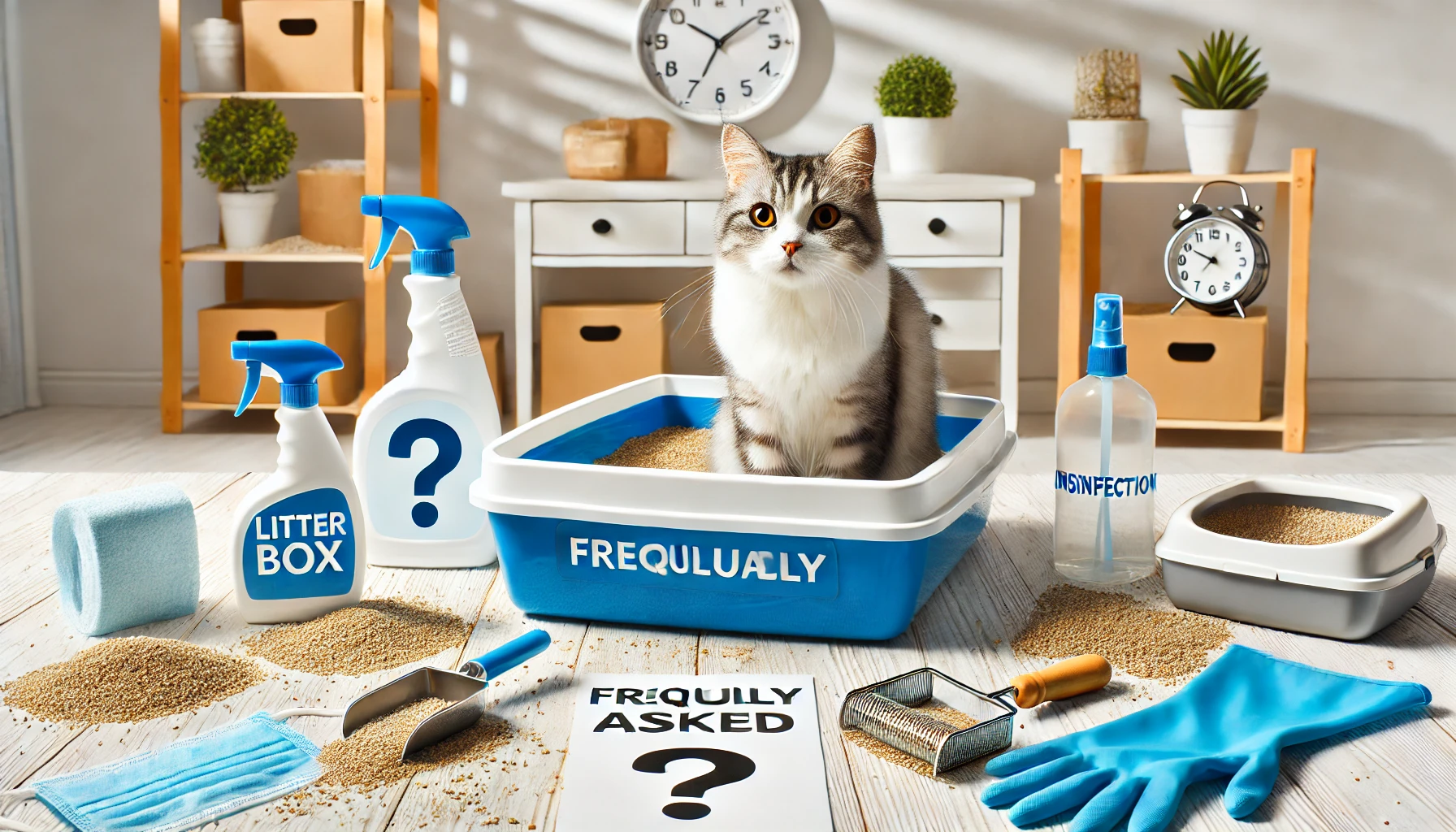
Frequently Asked Questions About Cleaning and Maintaining a Cat Litter Box
Here are some of the most frequently asked questions about how to keep your cat’s litter box clean, hygienic, and safe.
How often should I clean my cat's litter box?
Scooping your cat’s litter box is recommended once or twice a day.
Clumping litter should be fully changed every one to two weeks, while non-clumping litter may require more frequent changes to maintain cleanliness and odor control.
What type of litter is best to minimize odors?
Clumping cat litter is great for minimizing odors, as it forms clumps that are easy to scoop, reducing waste buildup.
Unscented natural litters are also a good option as they help prevent respiratory issues while controlling odors.
How can I keep my house from smelling like a litter box?
Scoop the litter box regularly, use high-quality litter designed for odor control, and place the litter box in a well-ventilated area.
Additionally, using a cat litter deodorizer can help neutralize unpleasant smells.
Is it safe to flush cat litter down the toilet?
No, flushing cat litter can clog plumbing and introduce harmful bacteria into water systems.
Always dispose of used litter in a sealed plastic bag and place it in an outdoor garbage bin to avoid contamination.
How do I clean my cat's litter box safely?
Always wear gloves while cleaning the litter box, and wash your hands thoroughly afterward.
Use pet-safe disinfectants for deep cleaning, and avoid harsh chemicals that could harm or irritate your cat.
Why does my cat avoid using a dirty litter box?
Cats are clean animals and may refuse to use a litter box if it becomes too dirty.
Strong odors from the litter box may repel them, causing them to find other places to relieve themselves, leading to accidents around the house.

